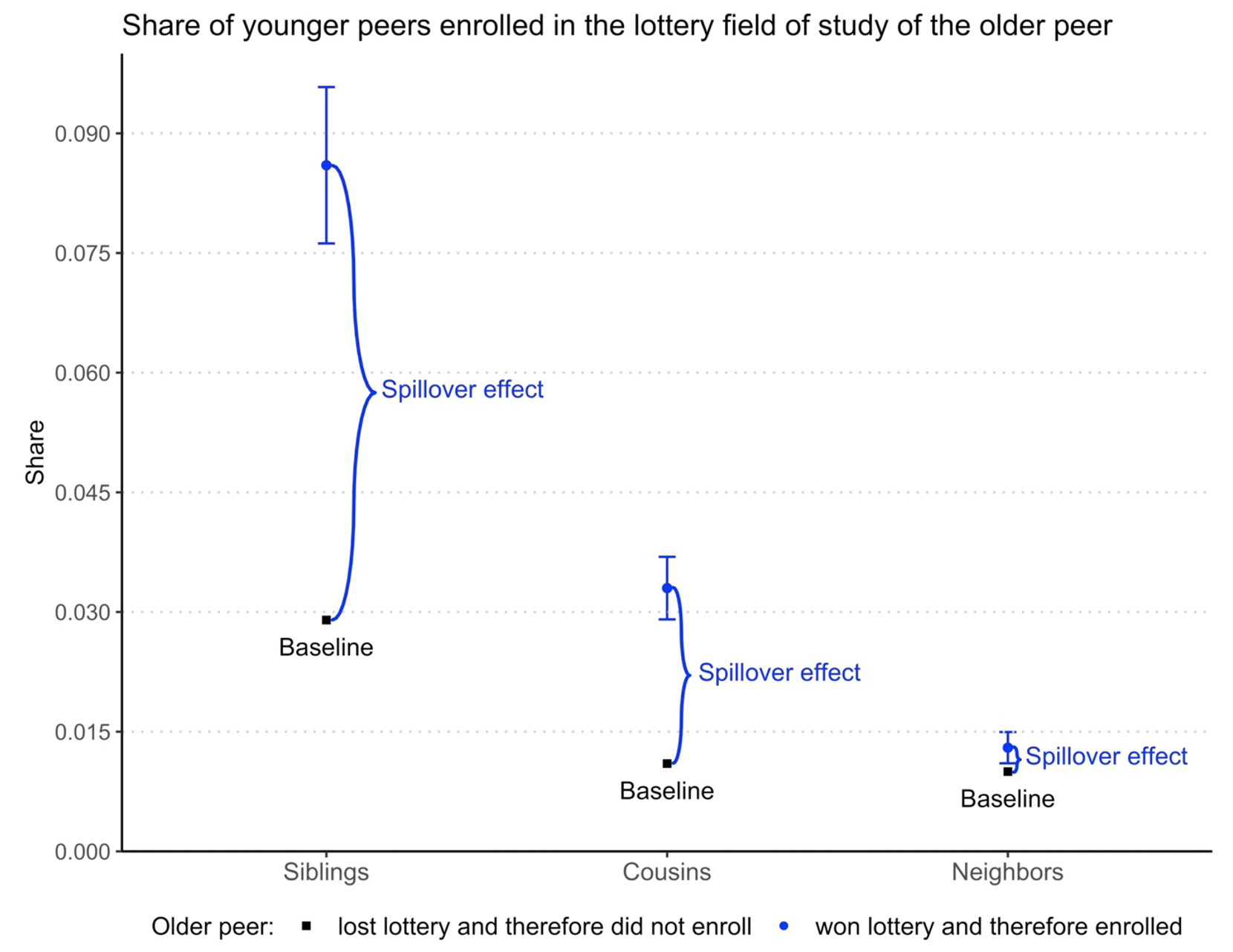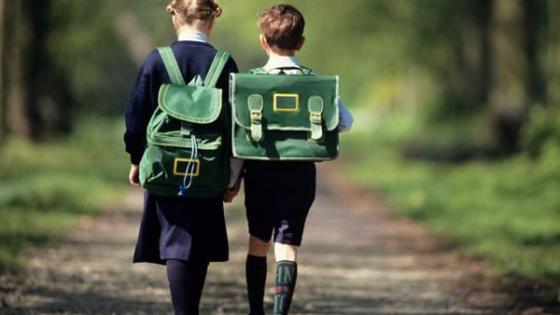The decision to enrol in higher education and what field of study to follow are among the most consequential choices an individual makes. These choices have large impacts on later-life earnings (Kirkeboen et al. 2016, Ketel et al. 2016, Dahl et al. 2020, Andrews et al. 2022), and other socioeconomic outcomes such as marriage, fertility, and health (Artmann et al. 2022, Kirkeboen et al. 2022). Yet, little is known about the determinants of field of study choices. At the same time, many educational institutions try to affect these choices, for example by applying affirmative action policies with the aim to diversify the student population. Wiswall and Zafar (2015) use a survey experiment providing students with information about major-specific characteristics, and conclude that “even with our rich data on beliefs across a variety of pecuniary and non-pecuniary aspects of majors, major-choices in our data are still largely the result of heterogeneity in major specific and unobserved ‘tastes’”.
Earlier research documented that study choices of family members and neighbours are (highly) correlated (Hallsten 2014, Goodman et al. 2015, van der Vleuten et al. 2020). This suggests that older peers are influential in determining the educational path of their younger peers. However, identifying peer spillovers is challenging: peers often grow up in a shared environment, making it hard to separate effects thereof from peer effects; if study choices are determined simultaneously, it is impossible to distinguish the effect of peers on the individual from the effect of the individual on peers (the reflection problem so named in Manski 1993).
A handful of recent studies have made progress in separating spillover effects from the effects of a shared environment by analysing the higher-education choices made by younger siblings and younger neighbours of applicants who were close to an admission threshold (Altmejd et al. 2021, Aguirrea 2021) or a loan eligibility threshold (Barrios-Fernández 2022) in regression discontinuity designs. Altmejd et al. (2021) use such designs in Chile, Croatia, Sweden, and the US, and find that younger siblings follow their older siblings to the same college or to the same college-major combination. In Chile, Aguirrea (2021) finds strong sibling spillover effects on university enrolment. Barrios-Fernández (2022) finds that neighbours are more likely to attend and complete university if their closest neighbour becomes eligible for a student loan. There are no earlier causal studies on cousin spillovers.
In a recent paper (Avdeev et al. 2023), we expand the evidence on spillovers in field of study choices using variation caused by higher-education admission lotteries in the Netherlands. During the period from 1987 to 1999, admission to oversubscribed fields of study was determined by the results of centralised admission lotteries. Fields of study in the health sector that ran admission lotteries are medicine, veterinary medicine, dentistry, occupational therapy, and biology. Other fields of study that ran admission lotteries are business, international business, and tourism. Due to the admission lotteries, some applicants to these fields of study were admitted while other equally qualified applicants were rejected. A large share of the rejected applicants ended up in another field of study. We use rich administrative data from Statistics Netherlands to link information from lottery participants to the study choices of a younger sibling, younger cousins, and younger neighbours. This allows us to analyse spillovers of fields of study on three different types of younger peers in one setting: siblings, cousins, and neighbours.
An important feature of the admission lotteries is that lottery losers are allowed to participate in subsequent lotteries in later years. We address this feature by using the results of the first lottery in which someone participated as an instrumental variable for enrolment in the field of study with the lottery. The units of the analysis in our study are sibling pairs, cousin pairs, and neighbour pairs. Siblings are individuals who have one or two parents in common. Cousins are individuals who have a common grandparent. Neighbours are individuals who live in the same neighbourhood. We consider spillovers on neighbours who are between one and two years younger than the lottery participant. The minimum age difference of one year is chosen to avoid reflection issues. The maximum age dfference of two years is chosen to increase the likelihood that neighbors interact with each other. Our analyses are based on more than 33,000 sibling pairs, almost 80,000 cousin pairs, and more than 317,000 pairs of neighbours.
Figure 1 shows that there are strong spillovers of the fields of study of the lottery participants on the fields of study choices of their younger peers. Relative to a baseline (control complier mean) of 2.9%, the younger siblings of lottery participants who enrolled in the lottery field of study because they won their first admission lottery are 5.7 percentage points more likely to enrol in that same field of study. For younger cousins, this effect is 2.2 percentage points (relative to a baseline of 1.1%), and for younger neighbours it is 0.3 percentage points (relative to a baseline of 1%).
Figure 1
The sibling spillovers are larger when the lottery participant and the younger sibling are of the same sex, suggesting a role model effect. There is no such interaction effect for cousins or neighbours. Neighbour spillovers are larger when the age difference between the lottery participant and the younger neighbour is smaller. With larger age differences, it is also less likely that neighbours interacted with each other. Finally, sibling and cousin spillovers are larger in high-income families, suggesting a role for parental resources.
Information about the factors that determine field of study choices is an important input for policies that aim to influence these choices. If certain barriers differentially affect individuals with different socio-economic backgrounds, this may partly explain persistent educational inequalities between these groups. The net effect of interventions to reduce such inequalities can differ substantially when there are substantial spillovers of such interventions to untreated groups (Black et al. 2017). This would arise if there were large social influences on higher education enrolments (Barrios-Fernández 2022).
Our findings indicate that a substantial part of the observed correlations in study choices between family members can be attributed to spillover effects and are not due to shared environments. These findings concur with those of recent studies based on admission thresholds, which find sibling spillovers on college and college-major choices. The similarity in results indicates that the results from these previous studies can be extrapolated to older peers, away from the admission threshold to a wider group of younger peers that includes cousins and neighbours. Moreover, while the previous studies find spillovers for college and college-major choices, our results demonstrate that even field of study choices are malleable.
Many countries have policies aimed at influencing young people’s study choices, such as affirmative action or policies to attract more women to STEM fields. Our results suggest that such policies can have multiplier effects, through family and neighbourhood networks. Our findings concerning differential effects by sex composition and family income indicate that these multiplier effects are not the same for everyone. Taken together, this implies that an admitted student from a disadvantaged background can act as a role model for younger (disadvantaged) peers to make the same study choice. To maximise such a role model effect, the student characteristics of the role model should be taken into account.
References
Altmejd, A, A Barrios-Fernández, M Drlje, J Goodman, M Hurwitz, D Kovac, C Mulhern, C Neilson and J Smith (2021), “O Brother, Where Start Thou? Sibling Spillovers on College and Major Choice in Four Countries”, Quarterly Journal of Economics 136(3): 1831–86.
Andrews, R J, S A Imberman, M F Lovenheim and K M Stange (2022), “College Majors affect more than just average earnings”, VoxEU.org, 27 October.
Artmann, E, N Ketel, H Oosterbeek and B van der Klaauw (2021), “Field of Study and Partner Choice”, Economics of Education Review 84 (102149): 1–7.
Avdeev, S, N Ketel, H Oosterbeek and B van der Klaauw (2023), “Spillovers in Fields of Study: Siblings, Cousins, and Neighbors”, CEPR Discussion Paper No. 18587, London: CEPR Press.
Barrios-Fernández, A (2022), “Neighbors’ Effects on University Enrollment”, American Economic Journal: Applied Economics 14(3): 30–60.
Black, S, S Breining, D Figlio, J Guryan, K Karbownik, J Roth, M Simonsen and H Skyt Nielsen (2017), “Sibling spillovers”, VoxEU.org, 8 July.
Bleemer, Z and A Mehta (2022), “Will Studying Economics Make You Rich? A Regression Discontinuity Analysis of the Returns to College Major”, American Economic Journal: Applied Economics 14(2): 1–22.
Dahl, G, D Rooth and A Stenberg (2020), “Earnings payoffs to different fields of study in secondary school”, VoxEU.org, 10 November.
Goodman, J, M Hurwitz, J Smith and J Fox (2015), “The Relationship Between Siblings’ College Choices: Evidence from One Million SAT-Taking Families”, Economics of Education Review 48: 75–85
Hällsten, M and M Kolk (2023), “The Shadow of Peasant Past: Seven Generations of Inequality Persistence in Northern Sweden”, American Journal of Sociology 128(6): 1716–60.
Ketel, N, E Leuven, H Oosterbeek and B van der Klaauw (2016), “The Returns to Medical School: Evidence from Admission Lotteries”, American Economic Journal: Applied Economics 8(2): 225–54.
Kirkeboen, L, E Leuven and M Mogstad (2016), “Field of Study, Earnings, and Self-Selection”, Quarterly Journal of Economics 131(3): 1057–1111
Kirkeboen, L, E Leuven and M Mogstad (2022), “College as a Marriage Market”, NBER Working Paper 28688.
Manski, C F (1993), “Identification of Endogenous Social Effects: The Reflection Problem”, Review of Economic Studies 60(3): 531–42.
van der Vleuten, M, J Weesie and I Maas (2020), “Sibling Influence in Field of Study Choices”, Research in Social Stratification and Mobility 68 (100525): 1–18
Wiswall, M and B Zafar (2015), “Determinants of College Major Choice: Identification using an Information Experiment”, Review of Economic Studies 82(2): 791–824.







